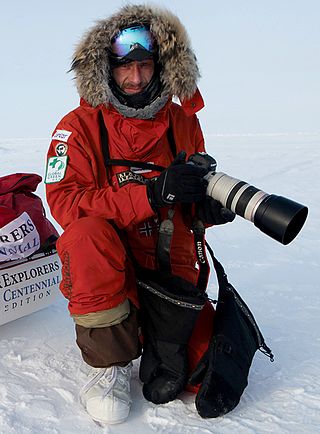
Transport in Antarctica has transformed from explorers crossing the isolated remote area of Antarctica by foot to a more open era due to human technologies enabling more convenient and faster transport, predominantly by air and water, but also by land as well. Transportation technologies on a remote area like Antarctica need to be able to deal with extremely low temperatures and continuous winds to ensure the travelers' safety. Due to the fragility of the Antarctic environment, only a limited amount of transport movements can take place and sustainable transportation technologies have to be used to reduce the ecological footprint. The infrastructure of land, water and air transport needs to be safe and sustainable. Currently thousands of tourists and hundreds of scientists a year depend on the Antarctic transportation system.

The United States Antarctic Program is an organization of the United States government which has a presence in the Antarctica continent. Founded in 1959, the USAP manages all U.S. scientific research and related logistics in Antarctica as well as aboard ships in the Southern Ocean.

The South Pole Traverse, also called the South Pole Overland Traverse (SPoT), or McMurdo–South Pole Highway is an approximately 995-mile-long (1,601 km) flagged route over compacted snow and ice in Antarctica that links McMurdo Station on the coast to the Amundsen–Scott South Pole Station, both operated by the National Science Foundation of the United States. It was constructed by levelling snow and filling in crevasses; flags mark its route from McMurdo Station across the Ross Ice Shelf to the Leverett Glacier, where the route ascends to the polar plateau and on to the South Pole. It was constructed between 2002 and end of 2005, when it opened for the first time; it has gained several names and has been called the southernmost road in the world.
Benjamin John Saunders is an English polar explorer, endurance athlete, and motivational speaker. He led the first return journey to the South Pole on foot via Shackleton and Scott's route in 2013–14, and skied solo to the North Pole in 2004. Saunders has skied more than 3,700 miles (6,000 km) on polar expeditions since 2001. He holds the record for the longest human-powered polar journey in history (2,888 km) and for the longest solo Arctic journey by a Briton (1,032 km).
Eric Philips OAM is an Australian polar explorer, adventurer, polar guide and private astronaut.

The South Pole, also known as the Geographic South Pole or Terrestrial South Pole, is the point in the Southern Hemisphere where the Earth's axis of rotation meets its surface. It is called the True South Pole to distinguish from the Magnetic South Pole.

Willis Group Holdings plc was a multinational risk advisor, insurance brokerage and reinsurance brokerage company headquartered in the Willis Building in London. It was the third-largest insurance broker worldwide by revenues. In 2016, the company acquired Towers Watson and was renamed Willis Towers Watson.

Sebastian Copeland is a British-American-French photographer, polar explorer, author, lecturer, and environmental advocate. He has led numerous expeditions in the polar regions to photograph and film endangered environments. In 2017, Copeland was named one of the world's top 25 adventurers of the last 25 years by Men's Journal. He is a fellow of The Explorers Club. His documentary Into the Cold was a featured selection at the 2010 Tribeca Film Festival and was released on DVD timed to Earth Day 2011.

Felicity Ann Dawn Aston is a British explorer, author and climate scientist.
Parker Liautaud is a climate researcher who has undertaken several polar expeditions. He graduated from Yale University in New Haven, Connecticut.
Ryan Waters is an American mountaineer, mountaineering guide, and polar skiing guide.
1990 International Trans-Antarctica Expedition was a 6,021-kilometre (3,741-mile), 220-day expedition and the first-ever non-mechanized crossing of Antarctica. The six-member, international team was co-led by U.S. team member, Will Steger and French team member, Dr. Jean-Louis Étienne. The other team members were Victor Boyarsky, Geoff Somers, Qin Dahe (China) and Keizo Funatsu (Japan). The expedition was operated in partnership with the Soviet Arctic and Antarctic Research Institute through a joint venture. Primary expedition sponsors were W. L. Gore and Associates and Union d'Assurances de Paris (UAP).

Lois M. Jones was an American geochemist who led the first all-woman science team to Antarctica in 1969. They were also the first women to reach the South Pole. Jones was well regarded for her contribution to geological research in the McMurdo Dry Valleys, one of the few ice-free areas of Antarctica, and published many papers and abstracts.

This is a Timeline ofwomen in Antarctica. This article describes many of the firsts and accomplishments that women from various countries have accomplished in different fields of endeavor on the continent of Antarctica.

Ramón Hernando de Larramendi is a Spanish polar explorer and adventure traveler who has promoted and developed a unique WindSled, intended for the research in Antarctica and Greenland. He has traveled more than 40,000 km in polar territories.
Johanna Davidsson is a Swedish nurse and adventurer. She is the Guinness World Record holder for skiing solo, unsupported from the coast of Antarctica to the South Pole.
Anja Karen Blacha is a German mountaineer. Blacha holds a number of climbing records: in 2017, she became the youngest German woman to climb Mount Everest and youngest German overall to climb all Seven Summits and in 2019 she became the first German woman to climb K2.









